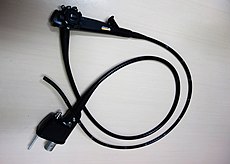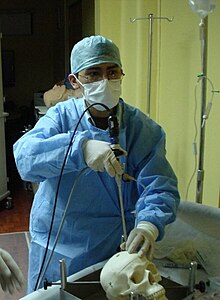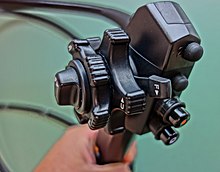Endoskopija — разлика између измена
. |
(нема разлике)
|
Верзија на датум 3. јул 2020. у 05:03
| Endoskop | |
|---|---|
| Intervencija | |
 Primer fleksibilnog endoskopa | |
| MeSH | D004724 |
| OPS-301 kod | 1-40...1-49, 1-61...1-69 |
| MedlinePlus | 003338 |

Jedan korisnik upravo radi na ovom članku. Molimo ostale korisnike da mu dopuste da završi sa radom. Ako imate komentare i pitanja u vezi sa člankom, koristite stranicu za razgovor.
Hvala na strpljenju. Kada radovi budu završeni, ovaj šablon će biti uklonjen. Napomene
|
Endoskopija (looking inside) is a procedure used in medicine to look inside the body.[1] The endoscopy procedure uses an endoscope to examine the interior of a hollow organ or cavity of the body. Unlike many other medical imaging techniques, endoscopes are inserted directly into the organ.
There are many types of endoscopes. Depending on the site in the body and type of procedure an endoscopy may be performed either by a doctor or a surgeon. A patient may be fully conscious or anaesthetised during the procedure. Most often the term endoscopy is used to refer to an examination of the upper part of the gastrointestinal tract, known as an esophagogastroduodenoscopy.[2] For non-medical use, similar instruments are called borescopes.
The self-illuminated endoscope was developed at Glasgow Royal Infirmary in Scotland (one of the first hospitals to have mains electricity) in 1894/5 by Dr John Macintyre as part of his specialization in investigation of the larynx.[3]
Medicinske upotrebe


Endoscopy may be used to investigate symptoms in the digestive system including nausea, vomiting, abdominal pain, difficulty swallowing, and gastrointestinal bleeding.[4] It is also used in diagnosis, most commonly by performing a biopsy to check for conditions such as anemia, bleeding, inflammation, and cancers of the digestive system.[4] The procedure may also be used for treatment such as cauterization of a bleeding vessel, widening a narrow esophagus, clipping off a polyp or removing a foreign object.[4]
Specialty professional organizations which specialize in digestive problems advise that many patients with Barrett's esophagus are too frequently receiving endoscopies.[5] Such societies recommend that patients with Barrett's esophagus and no cancer symptoms after two biopsies receive biopsies as indicated and no more often than the recommended rate.[6][7]
Istorija

The first endoscope was developed in 1806 by Philipp Bozzini in Mainz with his introduction of a "Lichtleiter" (light conductor) "for the examinations of the canals and cavities of the human body".[8] However, the Vienna Medical Society disapproved of such curiosity.[9] The first to use an endoscope in a successful operation was Antonin Jean Desormeaux whose invention was the state of the art before the invention of electricity.
The use of electric light was a major step in the improvement of endoscopy. The first such lights were external although sufficiently capable of illumination to allow cystoscopy, hysteroscopy and sigmoidoscopy as well as examination of the nasal (and later thoracic) cavities as was being performed routinely in human patients by Sir Francis Cruise (using his own commercially available endoscope) by 1865 in the Mater Misericordiae Hospital in Dublin, Ireland.[10] Later, smaller bulbs became available making internal light possible, for instance in a hysteroscope by Charles David in 1908.[11]
Hans Christian Jacobaeus has been given credit for the first large published series of endoscopic explorations of the abdomen and the thorax with laparoscopy (1912) and thoracoscopy (1910)[12] although the first reported thoracoscopic examination in a human was also by Cruise.[13]
Laparoscopy was used in the diagnosis of liver and gallbladder disease by Heinz Kalk in the 1930s.[14] Hope reported in 1937 on the use of laparoscopy to diagnose ectopic pregnancy.[15] In 1944, Raoul Palmer placed his patients in the Trendelenburg position after gaseous distention of the abdomen and thus was able to reliably perform gynecologic laparoscopy.[16]
Vulf and Storz
Georg Vulf (1873–1938) a Berlin manufacturer of rigid endoscopes, established in 1906, produced the Sussmann flexible gastroscope in 1911 (Modlin, Farhadi-Journal of Clinical Gastroenterology, 2000).[17] Karl Storz began producing instruments for ENT specialists in 1945 through his company, Karl Storz GmbH.[18]
Reference
- ^ „Endoscopy”. British Medical Association Complete Family Health Encyclopedia. Dorling Kindersley Limited. 1990.
- ^ „Endoscopy”. Cancer Research UK. Приступљено 5. 11. 2015.
- ^ „The Scottish Society of the History of Medicine” (PDF).
- ^ а б в Staff (2012). „Upper endoscopy”. Mayo Clinic. Приступљено 24. 9. 2012.
- ^ American Gastroenterological Association, „Five Things Physicians and Patients Should Question” (PDF), Choosing Wisely: an initiative of the ABIM Foundation, American Gastroenterological Association, Архивирано из оригинала (PDF) 9. 8. 2012. г., Приступљено 17. 8. 2012
- ^ Spechler SJ, Sharma P, Souza RF, Inadomi JM, Shaheen NJ (март 2011). „American Gastroenterological Association medical position statement on the management of Barrett's esophagus”. Gastroenterology. 140 (3): 1084—91. PMID 21376940. doi:10.1053/j.gastro.2011.01.030.
- ^ Wang KK, Sampliner RE (март 2008). „Updated guidelines 2008 for the diagnosis, surveillance and therapy of Barrett's esophagus”. The American Journal of Gastroenterology. 103 (3): 788—97. PMID 18341497.
- ^ Bozzini, Philipp (1806). „Lichtleiter, eine Erfindung zur Anschauung innerer Teile und Krankheiten, nebst der Abbildung” [Light conductor, an invention for examining internal parts and diseases, together with illustrations]. Journal der Practischen Arzneykunde und Wundarzneykunst (на језику: немачки). 24: 107—24.
- ^ Yamada T (2009-01-22). Atlas of Gastroenterology. John Wiley & Sons. ISBN 978-1-4443-0342-1.
- ^ Caniggia A, Nuti R, Lore F, Martini G, Turchetti V, Righi G (април 1990). „Long-term treatment with calcitriol in postmenopausal osteoporosis”. Metabolism. 39 (4 Suppl 1): 43—9. JSTOR 25204557. PMC 2325571
 . PMID 2325571. doi:10.1136/bmj.1.223.345.
. PMID 2325571. doi:10.1136/bmj.1.223.345.
- ^ Shawki O, Deshmukh S, Pacheco LA (2017). Mastering the Techniques in Hysteroscopy. Jaypee Brothers Medical Publishers. стр. 13—. ISBN 978-93-86150-49-3.
- ^ Litynski GS (1997). „Laparoscopy--the early attempts: spotlighting Georg Kelling and Hans Christian Jacobaeus”. JSLS. 1 (1): 83—5. PMC 3015224
 . PMID 9876654.
. PMID 9876654.
- ^ Gordon S (2014). „Art. VIII.—Clinical reports of rare cases, occurring in the Whitworth and Hardwicke Hospitals”. Dublin Quarterly Journal of Medical Science. 41 (1): 83—99. doi:10.1007/BF02946459.
- ^ Wildhirt E, Kalk H (1977). Neue Deutsche Biographie (NDB). Band 11. Berlin: Duncker & Humblot. стр. 60. ISBN 978-3-428-00192-7.
- ^ Balen AH, Creighton SM, Davies MC, MacDougall J, Stanhope R (2004-04-01). Paediatric and Adolescent Gynaecology: A Multidisciplinary Approach. Cambridge University Press. стр. 131—. ISBN 978-1-107-32018-5.
- ^ Litynski GS (1997). „Raoul Palmer, World War II, and transabdominal coelioscopy. Laparoscopy extends into gynecology”. Journal of the Society of Laparoendoscopic Surgeons. 1 (3): 289—92. PMC 3016739
 . PMID 9876691.
. PMID 9876691.
- ^ „About Richard Wolf Germany”. Richard Wolf Medical Instruments.
- ^ Nezhat C (2005). „Chapter 19. 1960's”. Nezhat's History of Endoscopy. Society of Laparoendoscopic Surgeons.
Spoljašnje veze
- The Atlas of Gastrointestinal Endoscopy endoatlas.com
- El Salvador Atlas of Gastrointestinal Endoscopy
- Gastrolab: Site in English, Swedish and Finnish with gastrointestinal endoscopy photolibrary
- Preventing cross-contamination from flexible endoscopes massdevice.com
- Advances in Endoscopy advancedimagingpro.com
 | Molimo Vas, obratite pažnju na važno upozorenje u vezi sa temama iz oblasti medicine (zdravlja). |
